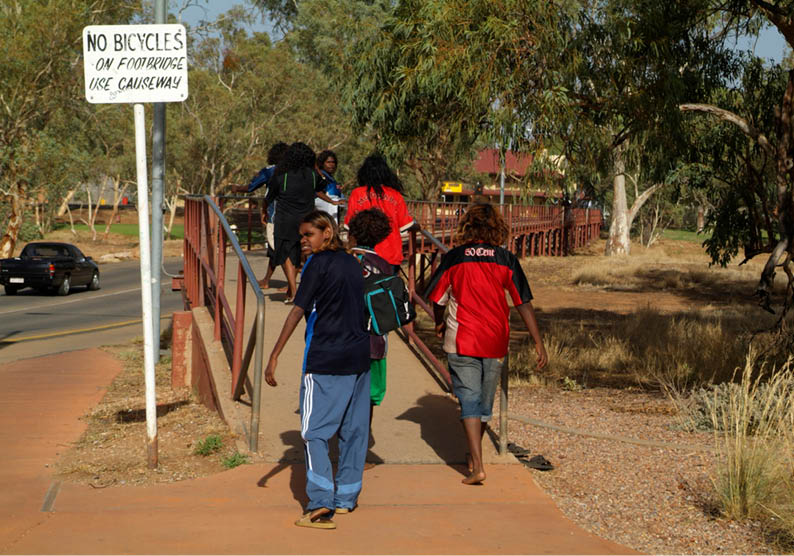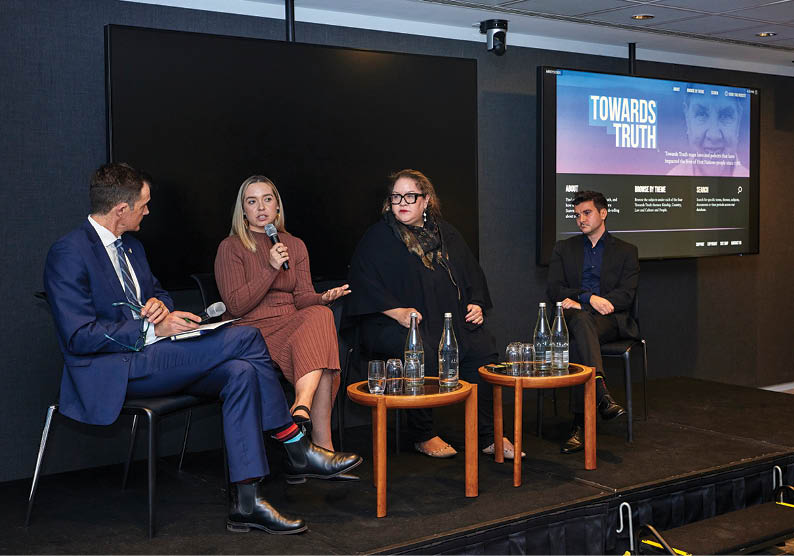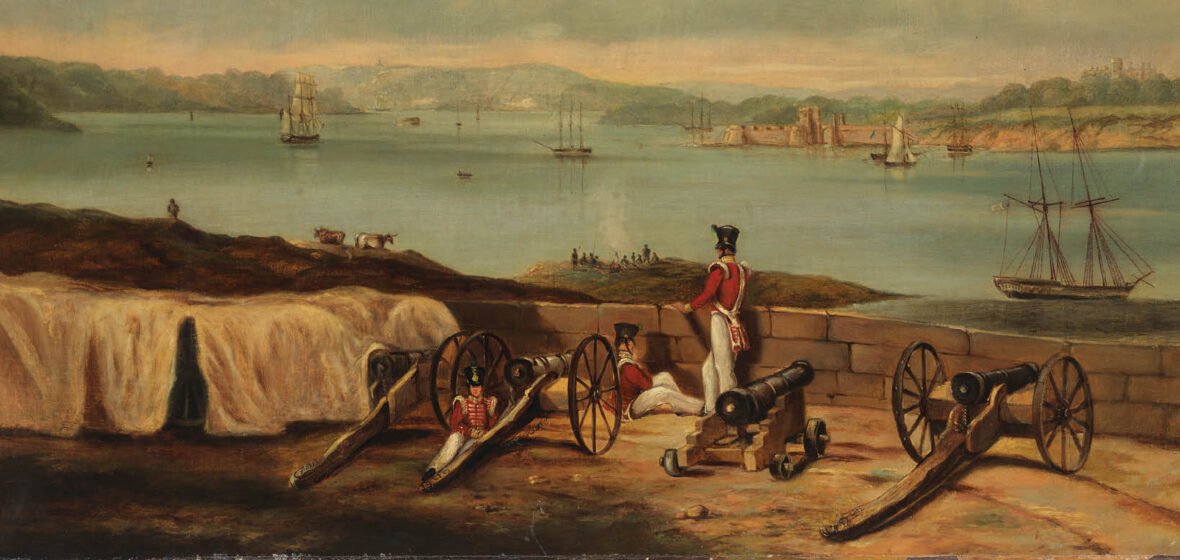Towards Truth is a new website that aims to expose the many decisions made by our parliaments and other authorities that have disempowered and dispossessed Indigenous people from the beginning of colonisation until today. It also tells a story of resilience and resistance – the long history of Aboriginal people fighting for justice and driving reform.
In November 1847, 23 Gumbaynggir people were murdered by poisoning at Kangaroo Creek in the Grafton area. Twelve years later, a brutal attack was made on what was thought to be up to 400 Ngiyampaa people near Brewarrina. The site came to be known as Hospital Creek owing to the large number of people killed there.
Stories like these, of atrocities inflicted upon Aboriginal people in what has been labelled “Frontier violence”, might be familiar. But the laws that contributed to the failure of the justice system to hold the perpetrators to account are less well known.
Towards Truth shines a light on those laws. It is an ambitious new website that aims to expose the many decisions made by our parliaments and other authorities that have disempowered and dispossessed First Nations people from the very beginning of colonisation until today.
Towards Truth emerged after First Nations participants at the Uluru Dialogues spoke about the need for Australians to know their history. It responds to the call for Truth made in the Uluru Statement from the Heart.
A partnership between the UNSW’s Indigenous Law Centre, led by Scientia Professor Megan Davis, and the Public Interest Advocacy Centre, Towards Truth also draws on extensive pro bono support from across the legal community, including several top Australian law firms.
The collection of laws, parliamentary speeches and commentary on the website gives a stark account of how law and policy have robbed too many First Nations people of land, family and culture. But Towards Truth also tells a story of resilience and resistance – the long history of Aboriginal people fighting for justice and driving reform. This can be witnessed in decades-long advocacy for the recognition and maintenance of connections to family, community, culture and country in child welfare laws, advocacy for land and water rights and much more.
In a year with so much focus on the role of First Nations people in Australian law-making, Towards Truth can help Australians understand the unique impact laws have had on First Australians and why the request to be heard is such a profound one. For the legal profession, it offers insight into the myriad ways First Nations people have been, and continue to be, touched by the legal system and government decisions. It is a reminder of the human impacts of our work interpreting, applying and advising on laws.
The hidden impact of laws and policies
Since 1788, Australian parliaments have passed laws specifically devised to control the lives of Aboriginal people. For example, the Aborigines Protection Act 1909 (NSW) notoriously empowered the Aborigines Protection Board to control where Aboriginal people lived and worked.
There were countless other laws that did not explicitly refer to Aboriginal people, or were passed without the intention of discriminatory effects, but nonetheless had dramatic impacts on the lives of Aboriginal people – from their language, culture and family relationships to their finances, land ownership and health.
There is a narrative amongst some sections of Australian society that our colonial origins were chaotic and the harm caused to Aboriginal people was unintentional. An examination of the laws that have governed voting and participation in the justice system shows it was often the legal system itself that created the conditions for that harm. Laws that made no mention of Aboriginal people nonetheless excluded them from taking an equal place in witness stands and polling places. And law makers who were well aware of the injustice caused did nothing, or too little, to avoid or remedy the injustice.
“Laws that made no mention of Aboriginal people nonetheless excluded them from taking an equal place in witness stands and polling places. And law makers who were well aware of the injustice caused did nothing, or too little, to avoid or remedy the injustice.”
The right to bear witness
Before the first fleet landed on Eora land, the UK parliament passed the New South Wales Courts Act 1787 (UK), which created a court of criminal judicature for the NSW penal colony. The first court case was heard at Sydney Cove on 11 February 1788 in front of a military officer who lacked formal legal training. The early militarised system of justice included public punishment such as hanging.
While the colonial court’s rules of evidence did not explicitly prevent Aboriginal people from giving evidence, interpretations of the law had that effect.
When a British man was charged with the murder of Aboriginal man Willie Cuthie in 1799, Cuthie’s Aboriginal wife asked to give her account of the alleged murder to the court. But her evidence was disallowed because she was deemed “incapacitated from giving such testimony as could be admissible in law”. The British man was acquitted of murder.
Aboriginal people were viewed as not capable of taking a religious oath, which excluded their evidence from the justice system. This was despite the pervasive influence of missionaries attempting to Christianise Aboriginal communities.
The enactment of these views set a dangerous precedent for the following century. Aboriginal witnesses to the worst of crimes were disallowed from giving their account in a legal institution supposed to protect them.
In 1805, while presiding over colonial courts, Judge Advocate Richard Atkins expressed the view that “the evidence of [p]ersons not bound by any moral or religious tye [sic] can never be considered or construed as legal evidence”. This widely-cited statement had clear influence over legal contemporaries. Its application can likely be seen in the trials of R v Luttrell (1810) and R v Hawker (1822), where white colonists were tried for acts of violence against Aboriginal victims, but no Aboriginal witnesses gave evidence in the proceedings.
Some might attempt to write off the exclusion of Aboriginal people from giving evidence as a product of a less enlightened time. But the injustice of this was recognised in the NSW Parliament as early as 1824, when the Attorney General described the judiciary’s stance as “one of the greatest practical absurdities ever committed by the Courts”.
Atrocities drive attempts at reform
There was an attempt to change the law soon after the 1838 Myall Creek Massacre, where at least 28 Aboriginal people were slaughtered by white colonialists. The Aboriginal Native Witnesses Bill introduced into NSW Parliament would have allowed Aboriginal people to give evidence in court after making an affirmation or declaration that they would tell the truth.
The Bill passed NSW Parliament but was rejected by the UK Parliament on the basis that “to admit, in a criminal case, the evidence of a witness acknowledged to be ignorant of the existence of a God, or a future state, would be contrary to the principles of British jurisprudence”.
Aboriginal people continued to be slaughtered. Family and community members witnessing the atrocities continued to be excluded from the courts. In 1842, the Chief Protector of the Aborigines argued: “There is … reason to fear that the destruction of the aboriginal natives has been accelerated from the known fact of their being incapacitated to give evidence in our courts of law”.

Years later, at least 23 Aboriginal people were poisoned to death at Kangaroo Creek NSW, but the case against the accused non-Aboriginal man did not proceed. The massacre was well known to the colony and the Parliament, which is why the Attorney General labelled it “one of the many cases from which the defect of the present law, in excluding altogether the evidence of the Aboriginal natives is apparent”. He later reflected: “All the natives agreed to the same story … it was the legal evidence only that was wanting, and for want of this the parties whose guilt was well known, escaped the hand of justice”. The Bill was defeated by just one vote and did not become law.
The law continued to exclude Aboriginal people as witnesses until 1876 – almost 90 years after the first NSW court was established. With the passing of the NSW Evidence Act, any person, including an Aboriginal person, could give evidence without taking an oath. It was perhaps Aboriginal trackers working for the NSW police, more than any other section of the Aboriginal community, who were called upon to give evidence in court. Despite the Act, some judges continued to rule Aboriginal evidence inadmissible.
Colonial parliaments and authorities knew of the killings of Aboriginal people by British subjects throughout the 19th century. Historic evidence shows they also knew the chilling effect their laws and practices were having on achieving justice. This raises questions: did atrocities occur extralegally? Or is it the more uncomfortable truth that key decision makers in legal institutions permitted and legitimised racial violence against Aboriginal people?
“The Electoral Act 1858 (NSW) disqualified people from voting if they were in receipt of “charitable aid”. This was interpreted to apply to Aboriginal people forced to live on government stations and reserves – people whose lives were fully controlled by station managers who provided food rations in exchange for forced labour.”
The right to vote
Voting is fundamental to a democratic society. By choosing elected representatives, citizens have some control over the decisions made in their communities.
In NSW, laws have never explicitly excluded Aboriginal people from voting. But the application of voting laws has presented them with many barriers.
For the first 35 years of the penal colony, autocratic Governors ruled NSW. This ended in 1823, when the NSW Legislative Council was established. Two-thirds of the members were elected by the public – but only men who owned or leased property of a certain value were allowed to vote. This excluded most, if not all, Aboriginal men. Although the requirements relaxed over the coming decades, new laws excluding Aboriginal people from voting came into force.
The Electoral Act 1858 (NSW) disqualified people from voting if they were in receipt of “charitable aid”. This was interpreted to apply to Aboriginal people forced to live on government stations and reserves – people whose lives were fully controlled by station managers who provided food rations in exchange for forced labour.
In 1902, the NSW Crown Solicitor gave advice that “aborigines … in receipt of rations and other assistance at the time of making out the lists or the holding of an election, cannot vote”. In 1918, when asked in Parliament if Aboriginal people in certain electorates were enrolled to vote, the Acting Premier responded “yes” but clarified: “in many cases aborigines come within the provisions of section 20(3)(b) of the Parliamentary Electorates and Elections Act as being in receipt of aid from some public charitable institution and are thus debarred from voting”.
The disqualification operated until 1928, when voting became compulsory for all NSW residents. More than 30 years later, a select committee report found there was no enforcement of compulsory voting by Aboriginal people in NSW. Shockingly, it was not until 1965 that all Aboriginal people could vote in federal elections and 1984 that voting in federal elections became compulsory for Aboriginal people.
Consorting laws and ongoing discrimination
Aboriginal people continue to be dramatically and disproportionately impacted by laws and policies directed to the general community. The use of consorting laws in NSW over the past decade is a clear-cut example.
In 2012, sparked by a spate of drive-by shootings in southwestern Sydney, the NSW Government “modernised” consorting laws as part of a crackdown on outlaw motorcycle gangs.
Consorting laws have existed in NSW in various forms since 1929. They allow police to warn a person not to associate with another person who has been convicted of an indictable offence. After receiving a warning, a person can be charged with an offence simply for spending time with at least two convicted offenders on at least two occasions, even where there is no unlawful intention or criminal purpose.
The Government’s aim was to curb organised crime. Then Premier Barry O’Farrell said the new laws would “make it harder for criminal gangs to engage in planned criminal activity”. When the reforms were introduced into Parliament, the stated objective was to ensure “that the provisions of the [Crimes] Act remain effective at combating criminal groups in NSW” and the NSW Police Force “has adequate tools to deal with organised crime”. But police publications noted“these new powers will be a valuable tool for frontline police when targeting high risk and recidivist offenders within their [Local Area Commands]”, suggesting these powers had a wider use.

Impact on Aboriginal communities
In practice, the application of the laws has extended well beyond combating organised crime, with many local area commands using consorting laws as a preventative tool in their communities.
Their reach into Aboriginal communities has been expansive and oppressive. The potential for a disproportionate impact on Aboriginal people was foreshadowed in the parliamentary debate when the laws were introduced. Reports by the NSW Ombudsman and the Law Enforcement Conduct Commission (LECC) demonstrate how this has been borne out.
The 2016 NSW Ombudsman’s report on the consorting law recognised the law “may criminalise associations that include a range of normal, everyday interactions between people that are otherwise unrelated to any criminal activity”. It found that, while Aboriginal people made up only 2.5 per cent of the population, 37 per cent of people subject to the laws were Aboriginal.
The report found specialist squads, in particular the Gangs Squad, were significantly less likely to use consorting laws against Aboriginal people than were general duties police officers (13 per cent of cases compared to 44 per cent of cases). It noted the use of the law by the Gangs Squad “involved a targeted and intelligence-driven approach”. In contrast, general duties officers used the laws in a wide range of situations including where only minor crimes or “nuisance offending” was involved.
The laws were amended in light of recommendations from the Ombudsman, and then reviewed by the LECC. The LECC’s 2023 report of this review highlighted ongoing disproportionate use against Aboriginal people. Specialist squads used the laws against Aboriginal people in 28 per cent of cases, while for general duties officer use the proportion was 46 per cent.
The LECC report gave clear examples of where the laws had been used against Aboriginal people in relation to minor offences. In one case, two people drinking in an alcohol-free zone in a park at 8pm were given move on orders and one was given a consorting warning when an ID check revealed their companion had previously been convicted of an indictable offence.
There are many factors at play here. The over-representation of Aboriginal people in the criminal justice system is reflected in an over-representation of Aboriginal people with an historic conviction of an indictable offence. This brings more people from Aboriginal communities within the scope of the consorting laws. Many small regional towns have significant Aboriginal communities with large kinship networks, which heightens the risk that people will be found spending time with prior offenders in public places.
While NSW Police have suggested the use of the consorting laws is “beneficial in achieving the goal of … reduc[ing] the number of Aboriginal and Torres Strait Islander people in the criminal justice system,” the LECC noted it is unclear how issuing a consorting warning would have reduced the risk of the Aboriginal people entering the criminal justice system in cases it had reviewed involving minor and nuisance offending.
The LECC instead observed, “a consorting warning takes a person one step closer to being eligible to be charged with an indictable offence with limited defences available to justify being in company with a person who has a conviction for an indictable offence”.
Even just receiving a warning, with no following charge, can have a dramatic impact on a person’s relationships. Aboriginal people can be – and often are – directed to stop associating with friends and family, with daily behaviour constantly monitored. As noted in the LECC review, maintaining healthy relationships to family and kin is essential in addressing issues such as high rates of suicide in the Aboriginal community. By breaking kin relationships, warnings about consorting can have a detrimental impact on the support systems available to the person. This highlights how high the stakes are when consorting laws are misused.
The offence of consorting has always contained an exception, in the form of a defence, for associating with family members. These defences have been found to have a significant influence on police officers’ exercise of their discretion to issue warnings. In response to the Ombudsman’s 2016 recommendations, the Government expanded the definition of “family member” to better cater to Aboriginal kinship and culture in 2018. However, there is no legislative requirement that an officer consider the defence when issuing a warning.
The LECC’s review noted difficulties in how kinship relationships are being considered in the process and recommended further training and guidance on this in police training and processes.
“The over-representation of Aboriginal people in the criminal justice system is reflected in an over-representation of Aboriginal people with an historic conviction of an indictable offence.”
Harmful predictive policing policy
To understand the breadth and depth of the impact of government actions on the lives of Aboriginal people, we also need to consider the policies and practices of government agencies.
The Suspect Target Management Plan (STMP) is a secretive, predictive policing strategy used by the NSW Police Force to target people for ongoing police attention. While organisations including PIAC have done extensive work to expose and critique the STMP, NSW Police has fervently guarded the secrecy around its operations.
The STMP began in 2002 and has had three iterations, each with the stated aim of targeting prior and “high risk” offenders through proactive policing. Police carry out a risk assessment before placing a targeted person on a Target Action Plan, which sets out the strategies police will use to disrupt criminal behaviour. The STMP authorises and encourages intrusive strategies such as stop and search, move on directions and regular home visits at any time of day or night.
The STMP is state-wide but applied at a local level by local commands in what has been described by the LECC as an unstructured and ad hoc manner.
Putting Aboriginal young people at risk
Policies like the STMP, which target people deemed “at risk” of offending, are open to bias. In a 2020 interim report on the use of the STMP against children and young people, the LECC recognised a risk of bias in the selection of targets. Documents revealed through NSW Parliamentary processes in April 2022 showed that, although “targets” are meant to be selected based on the Crime Severity Index, police have broad discretion as to who is placed on the program.
Because the STMP increases interactions between police and the people targeted, it increases the risk of criminalisation of targeted communities.
The use of the STMP against young Aboriginal people in NSW is alarming. The LECC’s interim report found 72 per cent of the children and young people selected for targeting had been identified by the Police as “possibly Aboriginal or Torres Strait Islander”. The NSW Police Force’s estimate was 42 per cent. Either figure is confronting.
These figures are especially concerning in light of the manipulation of relationships promoted by STMP policy. Police officers are encouraged to “build rapport and trust with family members through attending and re-attending their homes … [to] attempt to cultivate family members as sources”. The impacts of the STMP extend beyond the targeted Aboriginal person into their family and social networks. Whole communities become subject to increased vigilance and over-policing.
Inconsistent application of the STMP increases the risk of disproportionate impacts on young Aboriginal people. The STMP is being applied more readily to children and young people in rural and regional commands – areas with high numbers of children and young people identifying as Aboriginal and Torres Strait Islander.
Concerningly, the LECC reported that four young people who had never been charged with an offence were placed on the STMP. Three were Aboriginal, aged nine, 12 and 14.
The nine-year-old boy lived in rural NSW and, prior to becoming an active STMP target, had been identified by NSW Police as a victim of domestic violence and/or a “child or young person at risk”. Regardless, his STMP Target Action Plan listed no positive support strategies.
Over three years, this child was subject to ongoing, invasive interactions with police, including multiple searches, frequently being stopped and spoken to by police in his local area, regular home visits, and seven move on directions.
While he had no prior criminal record, the young person was charged 94 times after becoming an STMP target.
In NSW, nearly 30 per cent of adults and nearly 60 per cent of young people in custody are Aboriginal. It is critical that policing policies are carefully designed and applied to address these alarming figures.
There is clear evidence that exposing children to repeated, invasive interactions with police is harmful. The STMP creates negative associations with police and the criminal justice system and heightens the risk of a continued cycle of incarceration.
Learning from the past
Towards Truth continues to methodically analyse laws and policies, to expose how legal structures have resulted in trauma and disadvantage for First Nations people. While this is seen most clearly where Aboriginal people were the explicit targets of laws and policies, in many cases – such as those we have discussed in this article – it is the disparate and discriminatory impact of government action that has caused (and continues to cause) injustice.
Towards Truth compels us to reckon not just with our history, but also with its enduring impact and the ways in which laws and policies continue to perpetuate injustice. It is also a powerful reminder of how First Nations people have led reform to improve the relationship between the justice system and their communities.




